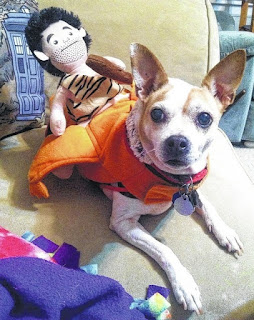If our dogs could talk to us, I’m certain they’d have lots to say. They’d tell us pizza is good for them and that cats are fair game, but along with this stuff, they’d probably give us some good advice. Here are some things I think they’d want us to know:
“I don’t really understand English, and I don’t always
know what you want.” Unless
you’ve taken the time to teach your dog what words and commands mean, you can’t
assume that he knows what you want him to do.
We may know what the command “Come” or “Stay” means, but the words are
meaningless to him unless you’ve taught him how you want him to respond.
“I’m afraid to come to you when you sound angry.” Dog
trainers everywhere will tell you that your dog must always feel safe and
welcome when you call him. Anger or
frustration in your voice may cause him to stay away, especially if he has ever
been disciplined right after coming to you.
It’s easy to say in theory, but hard to do in practice. No matter what you’ve had to endure to get
him to come, you’ll have to grit your teeth and tell him he’s a Good Boy when
he gets to you.
“I don’t do ‘revenge’ and I won’t ‘get back at you’
for something you did.” Your dog probably didn’t get into the trash
can or chew your favorite shoes to get back at you for not taking him to the
park. Chances are he did it to relieve
stress, or it was accessible and he was bored.
Thankfully, revenge isn’t an attribute of dogs.
“I have a ton of energy that I have to burn off one
way or another.” All dogs need
exercise and some breeds need lots of
it. Others are sedentary by nature and
can get away with much less. The amount
of physical exercise a particular dog needs should be one of the main things taken
into consideration before bringing a dog into the family. Need for vigorous exercise varies from breed
to breed, and from individual to individual.
If you don’t provide the dog with an acceptable way to burn off his
energy, you might not like the results.
“I’m way too little to feel safe with some kids.” Some
of the tiniest breeds really don’t belong in homes with small children. The kids will inevitably want to pick up the
dog to play with it or dress it up.
Young children don’t know the proper way to handle small dogs, and they
can injure them badly, especially if they drop the pup or step on it. Some tiny breeds are notoriously snappy
around small chldren, no doubt a character trait that has its roots in
self-defense.
“There is a whole world of adventure out there. My breed was born to chase and to run. How do you expect me to stay home if my yard
has no fence?” Dog trainers
hear this all the time – “My dog won’t stay on my property.” Physical boundaries such as fences or, in
some cases, “invisible” fences are the only real way to keep your dog home
unless he’s never let off the leash or is on a tie-out when he’s outdoors. Get out there and let him experience the
world in a safe manner – with you and under control, but keep him safely
contained in your yard when he’s outdoors without you. Don’t expect your hound, husky, or terrier to
just sit on the porch.
Living in a kennel at the far corner of the yard is so
lonely.” It’s not
fair to a dog to make it live in a kennel with minimal attention. Dogs are social creatures who need to
interact with their human families.
Train him and bring him into the house at least part of the time.
“I like being a dog.
Why don’t you try to see the world the way I do?” Try
to see things from your dog’s perspective. It will help you teach him what he needs to
know to be the perfect pet.
Dorothy Miner, featured above with her Airedale puppy, "Fergus," is a long-time dog obedience and tracking instructor,
judge of canine events, and author. She
teaches weekly classes for the Allen Correctional Institution’s PETS Program
in Lima, Ohio and provides training and consultation under the banner of “Sidekicks” and
“Training for Dogs and Their People.”










